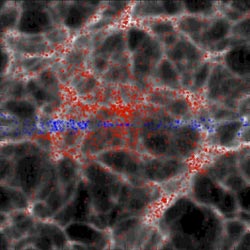Using artificial intelligence to chart the Universe

Supergalactic plot of the Cosmic Web Structure: A slice through the three dimensional Local Universe with side 370 Million light years is shown. The red circles represent observed galaxies from the 2MRS survey. The blue circles are random galaxies filled in the so-called zone of avoidance. The light and dark colour code stands for the density field reconstruction using the KIGEN artificial intelligence code. (AIP)<br>
Scientists routinely use large telescopes to scan the sky, mapping the coordinates and estimating the distances of hundreds of thousands of galaxies and so enabling scientists to map the large-scale structure of the Universe. But the distribution they see is intriguing and hard to explain, with galaxies forming a complex ‘cosmic web’ showing clusters, filaments connecting them, and large empty regions in between.
The driving force for such a rich structure is gravitation. Around 5 percent of the cosmos appears to be made of ‘normal’ matter that makes up the stars, planets, dust and gas we can see and around 23 percent is made up of invisible ‘dark’ matter.
The largest component, some 72 percent of the cosmos, is made up of a mysterious ‘dark energy’ thought to be responsible for accelerating the expansion of the Universe. This Lambda Cold Dark Matter (LCDM) model for the universe was the starting point for the work of the Potsdam team.
Measurements of the residual heat from the Big Bang – the so-called Cosmic Microwave Background Radiation or CMBR – allow astronomers to determine the motion of the Local Group, the cluster of galaxies that includes the Milky Way, the galaxy we live in. Astronomers try to reconcile this motion with that predicted by the distribution of matter around us, but this is compromised by the difficulty of mapping the dark matter in the same region.
“Finding the dark matter distribution corresponding to a galaxy catalogue is like trying to make a geographical map of Europe from a satellite image during the night which only shows the light coming from dense populated areas”, says Dr Kitaura.
His new algorithm is based on artificial intelligence (AI). It starts with the fluctuations in the density of the universe seen in the CMBR, then models the way that matter collapses into today’s galaxies over the subsequent 13700 million years. The results of the AI algorithm are a close fit to the observed distribution and motion of galaxies.
Dr Kitaura comments, “Our precise calculations show that the direction of motion and 80 percent of the speed of the galaxies that make up the Local Group can be explained by the gravitational forces that arise from matter up to 370 million light years away. In comparison the Andromeda Galaxy, the largest member of the Local Group, is a mere 2.5 million light years distant so we are seeing how the distribution of matter at great distances affects galaxies much closer to home.
Our results are also in close agreement with the predictions of the LCDM model. To explain the rest of the 20 percent of the speed, we need to consider the influence of matter up to about 460 million light years away, but at the moment the data are less reliable at such a large distance.
Despite this caveat, our model is a big step forward. With the help of AI, we can now model the universe around us with unprecedented accuracy and study how the largest structures in the cosmos came into being.”
Since 2011 Francisco Kitaura has been working at the AIP. His publication is available online on http://arxiv.org/abs/1205.5560 and will soon be published in Monthly Notices of the Royal Astronomical Society (MNRAS).
Science contact:
Dr. Francisco-Shu Kitaura, +49 331-7499 447, fkitaura@aip.de
Research, Images, Movies: http://www.aip.de/Members/fkitaura
Press contact:
Kerstin Mork, +49 331-7499 469, presse@aip.de
Leibniz Institute for Astrophysics:
The key areas of research at the Leibniz Institute for Astrophysics (Astrophysics Institute Potsdam – AIP) are cosmic magnetic fields and extragalactic astrophysics. A considerable part of the Institute's efforts aim at the development of research technology in the fields of spectroscopy, robotic telescopes, and e-science. The AIP is the successor of the Berlin Observatory founded in 1700 and of the Astrophysical Observatory of Potsdam founded in 1874. The latter was the world's first observatory to emphasize explicitly the research area of astrophysics. The AIP has been a member of the Leibniz Association since 1992.
Media Contact
All latest news from the category: Physics and Astronomy
This area deals with the fundamental laws and building blocks of nature and how they interact, the properties and the behavior of matter, and research into space and time and their structures.
innovations-report provides in-depth reports and articles on subjects such as astrophysics, laser technologies, nuclear, quantum, particle and solid-state physics, nanotechnologies, planetary research and findings (Mars, Venus) and developments related to the Hubble Telescope.
Newest articles

Superradiant atoms could push the boundaries of how precisely time can be measured
Superradiant atoms can help us measure time more precisely than ever. In a new study, researchers from the University of Copenhagen present a new method for measuring the time interval,…

Ion thermoelectric conversion devices for near room temperature
The electrode sheet of the thermoelectric device consists of ionic hydrogel, which is sandwiched between the electrodes to form, and the Prussian blue on the electrode undergoes a redox reaction…

Zap Energy achieves 37-million-degree temperatures in a compact device
New publication reports record electron temperatures for a small-scale, sheared-flow-stabilized Z-pinch fusion device. In the nine decades since humans first produced fusion reactions, only a few fusion technologies have demonstrated…





















